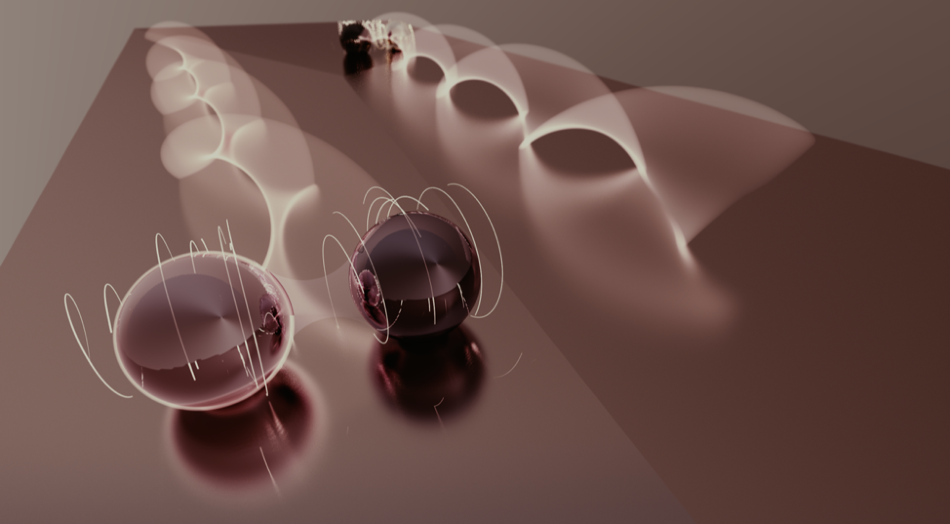Apr 6 2020
Particle chasing is a game that several physicists play. At times, the hunt occurs within huge supercolliders, where spectacular collisions are required to detect new physics and hidden particles.
 New measurements show evidence for the presence of exotic Majorana particles on the surface of an unconventional superconductor, Uranium ditelluride. Image Credit: Graphic provided by Dr E. Edwards, Managing Director of Illinois Quantum Information Science and Technology Center (IQUIST).
New measurements show evidence for the presence of exotic Majorana particles on the surface of an unconventional superconductor, Uranium ditelluride. Image Credit: Graphic provided by Dr E. Edwards, Managing Director of Illinois Quantum Information Science and Technology Center (IQUIST).
In the case of physicists who investigate solids, the game takes place in a very different environment and the desirable particles do not emerge from vigorous collisions. Rather, particle-like entities, known as quasiparticles, come from complex electronic interactions that occur deep within a material. At times, the quasiparticles can be explored easily, but others may be quite difficult to identify, hiding just out of reach.
Headed by physicist Vidya Madhavan, a research team from the University of Illinois has collaborated with scientists from the National Institute of Standards and Technology, the University of Maryland, Boston College, and ETH Zurich and used high-resolution microscopy tools to investigate the inner-workings of a strange type of superconductor—uranium ditelluride (UTe2).
Their measurements are strong proof that this material could include an exotic quasiparticle that has been hidden from physicists for several decades. The study has been reported in the March 26th issue of Nature.
The particles in dispute were hypothesized as early as 1937 by Ettore Majorana, an Italian physicist. Since then, physicists have been making efforts to prove their existence. According to researchers, a specific family of materials named chiral unconventional superconductors could be natural hosts to Majoranas. UTe2 could possess all of the optimal properties to produce these elusive quasiparticles.
We know the physics of conventional superconductors and understand how they can conduct electricity or transport electrons from one end of a wire to the other with no resistance. Chiral unconventional superconductors are much rarer, and the physics is less well known. Understanding them is important for fundamental physics and has potential applications in quantum computing.
Vidya Madhavan, Physicist, University of Illinois
Within a normal superconductor, the electrons couple such that lossless, persistent currents are enabled. This is contrary to a normal conductor, such as copper wire, which gets heated when current passes through it. Part of the theory behind superconductivity was proposed several decades ago by three scientists at the U of I, who were awarded a Nobel prize in physics for their studies.
Magnetic fields are the enemy for this traditional kind of superconductivity and disintegrate the pairs, restoring the material to normal. In the past year, scientists demonstrated that uranium ditelluride acts strangely.
In 2019, Sheng Ran, Nicholas Butch (both co-authors on this study), and their colleagues reported that UTe2 remains a superconductor when magnetic fields of up to 65 Tesla are present, which is nearly 10,000 times stronger compared to a refrigerator magnet. Owing to this strange behavior, together with other measurements, the authors of that study summarized that the electrons were coupling in a strange way that allowed them to resist disintegration.
The coupling is significant because superconductors with this characteristic could possibly have Majorana particles on the surface. The new study by Madhavan and her team strengthens the case for this.
The researchers employed a high-resolution microscope known as a scanning tunneling microscope to search for evidence of the strange electron pairing and Majorana particles. Apart from mapping the surface of uranium ditelluride down to the atomic level, the microscope can also investigate what happens to the electrons. The material itself has a silvery appearance, with steps jutting up from its surface.
Evidence for Majorana quasiparticles can best be observed in these step features. They offer a clear indication that, if assumptions are right, should reveal signatures of a continuous current traveling in a single direction, even without applying a voltage. Opposite sides of the step were scanned by the researchers, who observed a signal with a peak. However, the peak differed based on the side of the step that was scanned.
Looking at both sides of the step, you see a signal that is a mirror image of each other. In a normal superconductor, you cannot find that. The best explanation for seeing the mirror images is that we are directly measuring the presence of moving Majorana particles.
Vidya Madhavan, Physicist, University of Illinois
The researchers stated that the measurements point toward the fact that free-moving Majorana quasiparticles circulate together in a single direction, which causes mirrored, or chiral, signals.
According to Madhavan, the further step is to perform measurements to confirm that the material breaks time-reversal symmetry. This implies that the particles should travel differently upon theoretically reversing the arrow of time. A study such as this would offer additional proof for the chiral nature of UTe2.
Upon being confirmed, UTe2 would be the only material, apart from superfluid He-3, established to be a chiral unconventional superconductor.
This is a huge discovery that will allow us to understand this rare kind of superconductivity, and maybe, in time, we could even manipulate Majorana quasiparticles in a useful way for quantum information science.
Vidya Madhavan, Physicist, University of Illinois